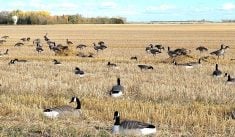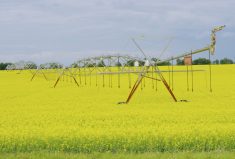LOCAL | Producers, particularly small-scale farmers, would benefit from similar regulations in Manitoba, says Direct Farm Manitoba
Demand for on-farm slaughter licences in Alberta has exploded since last summer when a rule change allowed consumers to buy individual animals and have them processed on the farm. Manitoba should have its own, similar regulations, says Direct Farm Manitoba.
The regulation changed last July to allow a producer to slaughter on farm and sell a whole animal (and its meat) to a customer for their household consumption. The uninspected meat cannot be distributed or sold outside of that agreement.
Read Also

Your best (and easiest) holiday dainty tray
Make-ahead recipes, store-bought goodies and co-operation with friends and family: Here’s how to throw together a stunning, low-stress tray.
As of mid-April, Alberta had issued 177 of the on-farm slaughter licences.
“The day that the regulation changed, my phone just blew up, and it was largely our customers calling because they were so thrilled,” said Blake Hall who owns and operates Prairie Gold Pastured Meats near Red Deer, Alta. with wife Angela.
“Overwhelmingly, they see the value in it, even if they are squeamish about it. They’re squeamish because they care about the animals, and the idea of them being carted all over the province and confined and handled roughly is what really makes them squeamish.
“They might not want to be a part of it, but they’re happy to know somebody who’s doing it on their behalf.”
Direct Farm Manitoba, which represents direct-marketing farmers and food producers and farmers’ markets, has long advocated for a similar regulation change in Manitoba. Last May, the group sent a letter to Manitoba Agriculture and Resource Development asking the province to “… begin planning now for some restricted form of on-farm processing of pork, beef and bison.”
At the time, COVID-19 outbreaks at meat processors was driving demand for local meat and putting pressure on small local processors.
Direct Farm Manitoba says it’s still looking to the province to legalize on-farm slaughter.
With the demands put on small local abattoirs and butchers, as well as the sometimes lengthy distances farmers have to go to access these services, the on-farm slaughter program could relieve some of that pressure and provide more options for our direct-marketing producers,” said executive director Kristie Beynon in an emailed statement.
Direct Farm Manitoba is consulting with the province on regulations for the recently passed Bill 36, which makes various amendments to the Public Health Act.
They’ve told the province that legal, on-farm slaughter is a specific example of how regulations can be made more accessible for small farms, said Direct Farm Manitoba president Phil Veldhuis.
The province will consider that approach as it develops regulations around Bill 36, said a spokesperson for Ag Minister Blaine Pedersen in a statement on June 17.
“We haven’t made any decisions and will consult with industry stakeholders on any regulations proposed. Food safety and animal welfare will continue to be priorities and need to be considered in the approach we’re taking,” the spokesperson said.
Benefits in Alberta
In Alberta, Hall began slaughtering his own cattle after working with the late Richard Griebel, who had pivoted to direct marketing and on-farm processing on his Castor, Alta. operation in response to BSE. At the time, on-farm slaughter wasn’t strictly legal. The Halls ran a herd-share program where customers would buy the animals live and then sign a contract waiving third-party inspection for the slaughter.
“I think if it came to be tested in a court of law, we would have been convicted of selling uninspected meat to the public,” said Hall, who knew of one farmer who was fined for running a similar program.
“That was a bit of a wake-up call, honestly. We started taking our beef to Penhold to get killed in the inspected plant there, and that’s still what we do.
“But when we started taking our meat to the plants to get killed, we heard about it in a big way from our customer base. They were really disappointed.”
For Hall, who will be returning to on-farm slaughter for customers who buy a whole animal, the new provincial meat inspection regulation is “definitely a step in the right direction.”
The pandemic drove some of that demand.
“When the federal plants shut down last year, that opened the eyes of a lot of consumers when they saw the meat supply dwindle in the grocery stores and the price go sky high,” said Hall. “I think this regulation change was a very appropriate response to the weakness in the federal supply chain that was revealed by the pandemic.
“Now we’re seeing more and more producers embracing the new regulation and supplying their local community with farm-raised beef.”
That’s creating a more resilient cattle industry in Alberta, said Ian Griebel, Richard’s son.
“With a lot of our meat processing, all of our eggs are in one basket, and we’ve seen what happens when we have problems with those baskets,” said Griebel, who took over the farm with his wife Dana Blume when his father passed.
“It jeopardized a huge food supply. So I think there’s some power in it. Instead of having two massive beef-processing facilities in the province, creating thousands of small ones. I think there’s some resilience in that.”
When Griebel took over the family farm about seven years ago, he decided he didn’t want to be a butcher and closed the little on-farm butcher shop. But in the past year, his sister and her husband — an English-trained butcher — have returned to the farm and reopened the butcher shop.
And with the legislation change, Griebel hopes to be doing more of the slaughter process on farm once again.
“We’re closing the loop,” he said. “These animals are raised on the farm from birth, they’re grazed here, now they’re dying here and we’re butchering them here. From a customer perspective, you’re buying an animal that isn’t ever really leaving this farm, which I think is kind of neat.”
Customers also appreciate the animal welfare aspect.
“The animal is slaughtered out on the grass. It’s a very stress-free slaughter compared to bringing those animals in,” said Griebel.
“In a typical system, we’ve got to sort them, they’ve got to be loaded on a trailer, they’re hauled on a stock trailer to a foreign site, where they’re unloaded and have to wait overnight to go down an alley system to be killed.
“For the animal, that whole process is quite stressful compared to just being shot right on the grass where they’re at.
“We’re closing the cycle of nature. The animal is being killed on the same grass that is feeding it.”
And the producer benefits, he added.
“Time, fuel, wear and tear on vehicles, the cost — we’re paying somebody else to slaughter these animals, and now we can put all of that back in our pockets. There’s a real financial benefit for the farmer.”
Quick and clean
Those factors were what drew Hall to explore on-farm slaughter on his own operation. After mentoring under Richard, he enrolled in Olds College to learn the art of slaughter and meat processing.
Now Hall harvests an average of five animals a day in his work as a mobile butcher, travelling from farm to farm with everything he needs to do the job “swiftly and cleanly.”
“Those are my main two criteria for success as I’m working — quick and clean,” he said. “It takes a high degree of skill, and when you’re shooting an animal in a pen, the margin for error increases.
“That would be the downside — if you have someone who is nervous or rushing and it leads to a missed shot where that animal isn’t stunned correctly, all that animal welfare stuff goes out the window pretty quickly.”
Cleanliness and food safety are, of course, also hugely important. But the relationship with the consumer in direct marketing means there is a low risk of “a shady actor” getting into the business, said Hall.
“If you sell an animal that’s going to be condemned into the federal supply, you probably won’t even hear about it,” he said. “If you make your neighbour sick, you’re out of business.”
Griebel agrees.
“You’re putting a lot of trust in the farmer that they’re doing everything properly, but you’re also really empowering the customer now to get to know their farmer, see their operation, and make sure that farmer is doing everything properly,” he said.
For many producers, those considerations might be too daunting to take on the task of on-farm slaughter themselves, and for those producers, that’s where licensed mobile butchers come in.
“These are the pros,” said Hall. “These are the people doing it every week who have the discipline to take a patient shot and doing it swiftly and cleanly.”
But for the producers who want to try their hand at slaughter themselves, Hall’s advice is to get some professional training.
“It’s not something to muddle your way through,” he said. “It’s not a trial-and-error kind of thing. It’s worth getting trained and learn from somebody who’s practiced in it before taking it on themselves.”
















